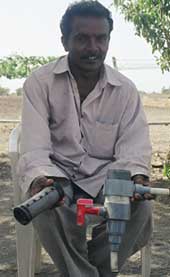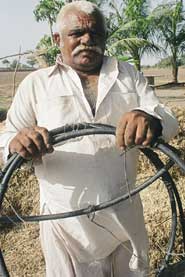Rural entrepreneurs
IDE has shown the way. Now small farmers are going a step further and coming up with
innovative modifications, that make grassroot level drip irrigation even cheaper and
simpler. They are able to set these systems up themselves and quickly get to the point
where they are comfortable enough to play around with these. Increasingly, instead of
buying the system from dealers, they buy the components directly from manufacturers and
assemble it themselves. The cost dips dramatically.
Jivanbhai Jasmat Rabadia is a
farmer from Moti Dhanej village in Banaskantha district, Gujarat. He has installed
low-cost drip in his brinjal fields by designing his own filter. Instead of buying one
from a branded manufacturer for about Rs 1500, he bought material worth Rs 500 to make a
similar filter himself. He now makes filters at home and sells them to his friends and
neighbours. He has full faith in the drip system he installed himself, especially after
getting a higher price for his brinjals since they are of a much better quality than those
in the market.
Using his one horsepower
motor, Kumarbhai Ram Jaitva can only pump water for 15 minutes from his well each
day before it goes dry. The only way he can use this water for cultivation is by using the
drip system. He has just eight laterals attached to a main line. This can water one bigha
of land. Instead of buying a system to cover all his land, he moves the small system along
the field after watering each section and manages to cover his eight bighas (about three
acres) of groundnut. He does this in the pre-monsoon season after sowing the crop and
achieves much better germination this way. So when the rains come, he will have a better
harvest.
The magic of Pepsee
Farmers have been carrying out a lot of innovations at the grassroot level to bridge the
gap between technology and cost. In some parts of Madhya Pradesh and Maharashtra, they
have experimented with bicycle tubes for drip irrigation. But these innovations were
confined to a limited area and most of them failed to catch on.
In the cotton belt along the Madhya
Pradesh-Maharashtra border, a low cost grassroots innovation called Pepsee has been
popular since 1988-89. They are made from low-density polythene (65-130 microns). At less
than half the cost of conventional drip systems, it promises comparable returns.
Local ice-cream sellers fill light
density disposable plastics with ice candies known as "Pepsee" in local markets.
The plastic is transparent and comes in 20 cm tubes. The candy manufacturers buy these
plastics in rolls which are then divided into smaller portions. The cost of the plastic
rolls comes to around Rs 50/kg for the manufacturer and Rs 70-75/kg for the farmer. This
plastic roll is today being used in place of drip tubes and is placed directly at the root
zone of the plants. The entire system is assembled locally. Initially, Pepsee was used for
cotton but over the years its use has spread to other crops.
The initial investment required for
Pepsee systems is 78 per cent less than for conventional drip systems. The investment
required for one acre of land under cotton is as low as Rs 4,000. Pepsee systems are
viewed as stepping stones by farmers as with minimal investment, they can try out new
technologies. Most farmers who discontinued with the use of Pepsee shifted to micro-tubes
or conventional drip systems as they were now more certain about the returns.
A survey of 180 farmers in Maikaal,
Madhya Pradesh and Jalgaon, Maharashtra found that the adoption of Pepsee systems leads to
a "notional" saving of water of up to 50 per cent compared to conventional
irrigation practices. However, this does not translate into real water saving as after
irrigating an acre of land using the Pepsee system, a farmer is able to save enough time
and water to irrigate 1.2 acres more. Eventually, the water depletion level remains as it
was before. This clearly points to the fact that unless these technologies are scaled up,
sporadic instances of successful adoption would not help in alleviating the problems of
groundwater depletion. The question now is: what might work best in promoting these
technologies on a mass-scale?
Shilp Verma
International Water Management Institute (IWMI-Tata),
Anand, Gujarat |
Kanabhai Punabhai Parmar in Malia
Taluka in Junagadh and his four brothers use IDE’s low-cost drip systems to irrigate
their four acres of betel land. Like a lot of other farmers in the area using drip, they
have taps on each of the lateral lines running along the rows of crops. They use this to
control the amount of water that flows in each line and the uniformity of drops. When
water is scarce, they can irrigate the field part by part, to make sure that each plant
gets enough water. Apart from saving on the cost of installing a sophisticated pressure
regulator, this method also involves personal supervision. This way, they know exactly how
the system works.
|



